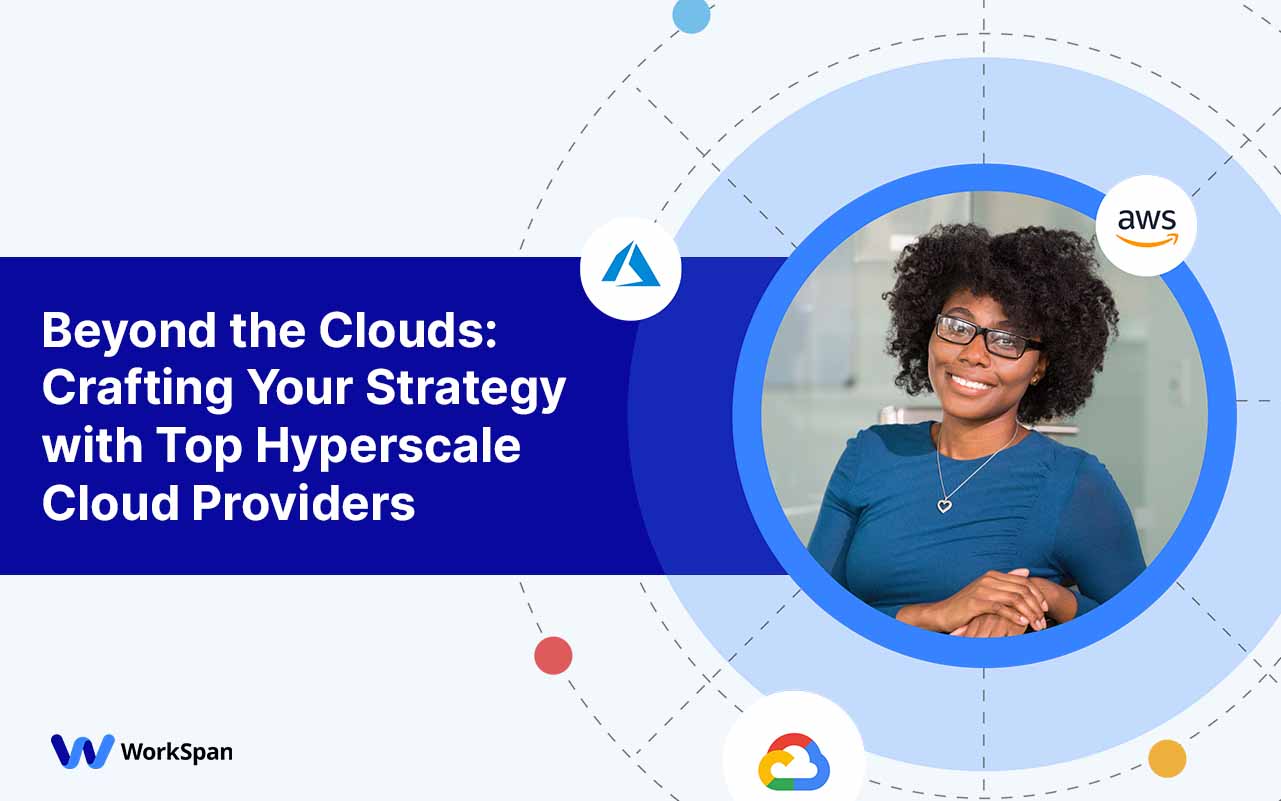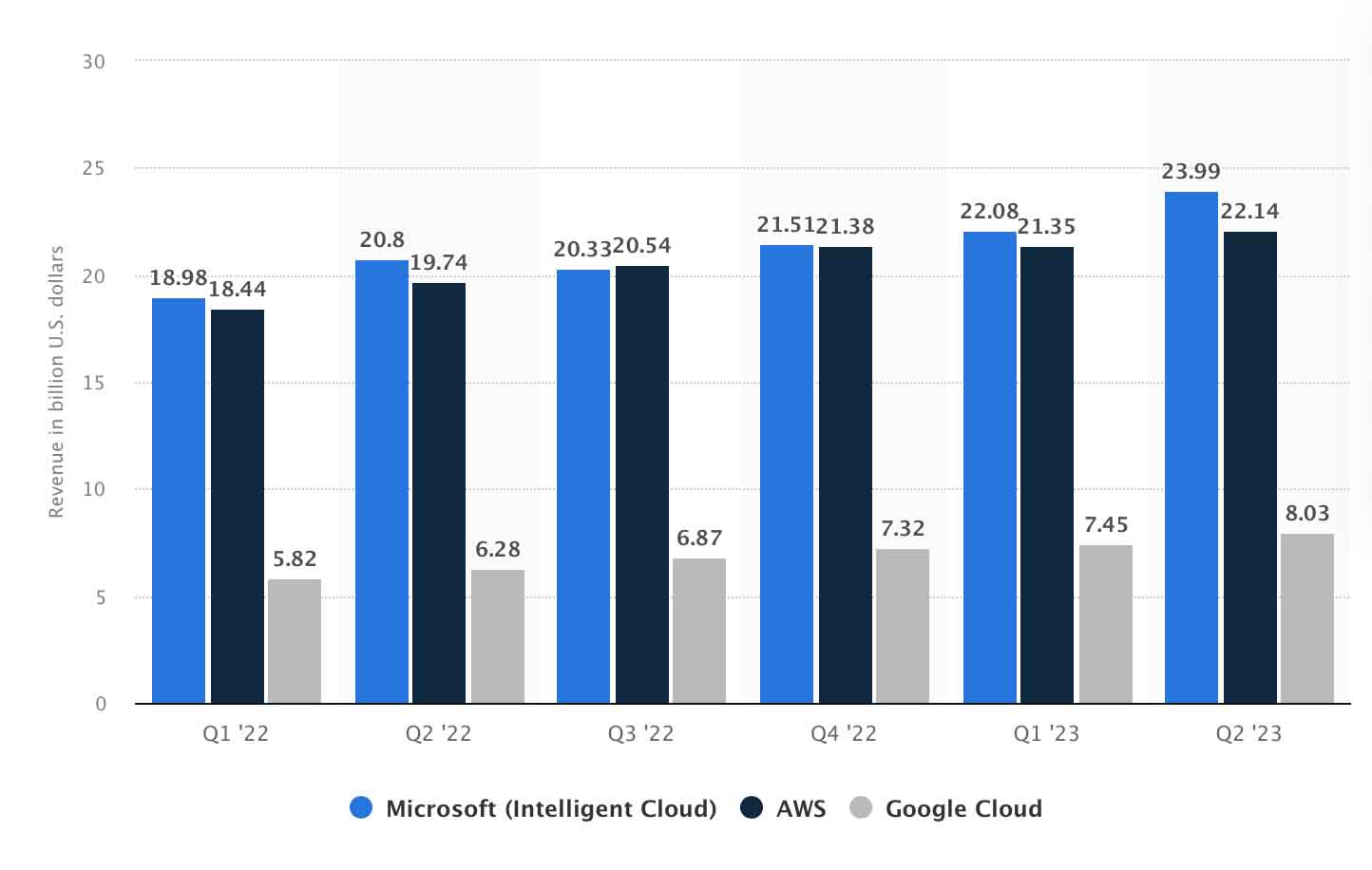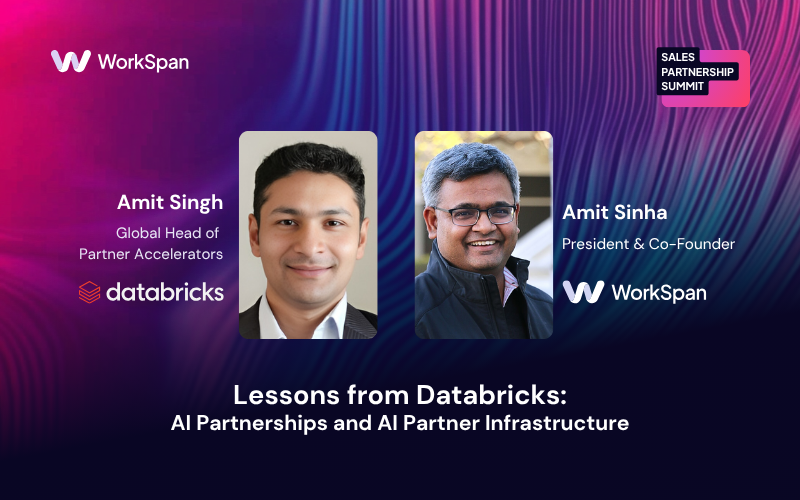
Hyperscale cloud providers, often known as industry giants, are companies that operate on an enormous scale to provide extensive and scalable cloud computing services globally. Key players in this arena include Amazon Web Services (AWS), Microsoft Azure, and Google Cloud Platform (GCP). These companies have positioned themselves as leaders in the cloud computing revolution by boasting vast data center networks and deploying cutting-edge technologies to offer a wide range of services.
Hyperscaler cloud providers are continuing to grow in popularity. Over half of businesses are projected to use industry-specific cloud platforms to expedite strategic endeavors by 2027. The largest hyperscalers continue to bring in tens of billions of dollars per quarter.

With so many lucrative options, choosing a hyperscale cloud provider can feel intimidating. Thoroughly evaluating cloud providers ensures alignment with your organization's unique requirements, offering tailored solutions that cater to your specific needs. To make this a little easier, we are covering:
- Hyperscalers Explained
- The Top Five Hyperscaler Cloud Providers
- Choosing The Hyperscale Cloud Provider That’s Right For You
Let’s dive in!
Hyperscalers Explained
The term "hyperscale" indicates these providers' ability to efficiently handle massive workloads and data processing. Their infrastructure is designed to scale horizontally, allowing businesses to access computing resources on-demand, such as computing power, storage, databases, and advanced technologies like machine learning and analytics. The largest hyperscaler companies have a global presence, strategically placing data centers across regions to ensure optimal performance and minimize latency for users worldwide.
Why hyperscalers?
Businesses opt for hyperscale cloud providers for several reasons. Firstly, they provide unparalleled scalability, enabling organizations to adapt quickly to changing workloads. The extensive service portfolios offer a diverse range of tools, fostering innovation and flexibility. Additionally, the global infrastructure enhances accessibility, ensuring businesses can reach users with low-latency services and robust connectivity. Security, compliance, and reliability are crucial considerations, as hyperscaler companies invest heavily in advanced security measures, providing a secure foundation for sensitive data and applications. In essence, leveraging hyperscale cloud services is driven by the pursuit of agility, scalability, and a robust technology infrastructure that aligns with the evolving needs of modern businesses.
LEARN MORE ABOUT THE ECONOMIC BENEFITS OF OF PARTNERING WITH HYPERSCALERS
The Top Five Hyperscaler Cloud Providers
While the strengths and drawbacks of cloud providers vary based on specific use cases, organizational requirements, and individual preferences, some stand out as universally popular options.
Amazon Web Services (AWS)
Amazon Web Services (AWS) is a leading cloud computing platform that offers a vast array of scalable and on-demand cloud services, including computing power, storage, databases, machine learning, analytics, and more. AWS is known for its global presence with data centers in multiple regions.
Strengths
- Comprehensive Service Offering: AWS provides an extensive range of cloud services, including computing power, storage, databases, machine learning, analytics, and more, catering to diverse business needs.
- Global Presence: AWS has a vast and geographically distributed network of data centers, enabling users to deploy resources in various regions for reduced latency and improved performance.
- Market Leader: As a pioneer in cloud computing, AWS is widely recognized as a market leader, boasting a large and diverse customer base that includes startups, enterprises, and public sector organizations.
- Ecosystem and Partner Network: AWS has a robust ecosystem with a broad range of partners, third-party integrations, and a supportive community, offering additional tools and services to users.
- Innovation: AWS is known for continuous innovation, regularly introducing new services and features, and staying at the forefront of emerging technologies like machine learning, serverless computing, and edge computing.
Drawbacks
- Complex Pricing: Varied factors influence costs, including data transfer fees and distinct pricing models for each service. Users must comprehend and manage usage for cost optimization.
- Learning Curve: AWS has a steep learning curve due to its extensive services, demanding time and effort, especially for beginners.
- Cost Management: Without diligent cost management, users risk unexpected overruns due to additional services or resources. Effective monitoring and budgeting are crucial.
- Dependency Concerns: Like any cloud provider, there are concerns about vendor lock-in. Users should consider long-term strategy and migration ease.
- Security Configuration: While AWS offers robust security, configuring and managing settings can be complex. Implementing security best practices is essential for a secure environment.
LEARN HOW WORKSPAN CAN HELP SCALE YOUR AWS PARTNERSHIPS
Microsoft Azure
Microsoft Azure is another large hyperscaler company, providing a broad set of cloud services and a strong focus on enterprise solutions. Azure is known for its integration with Microsoft products and services.
Strengths
- Integration with Microsoft Products: Azure seamlessly integrates with a wide range of Microsoft products and services, facilitating compatibility for organizations already invested in the Microsoft ecosystem.
- Hybrid Cloud Capabilities: Azure offers robust hybrid cloud solutions, allowing organizations to seamlessly integrate on-premises infrastructure with cloud services for a flexible and tailored approach.
- Enterprise Focus: Known for its strong focus on enterprise solutions, Azure provides a comprehensive suite of services suitable for large-scale and complex business needs.
- Global Data Center Presence: With a widespread network of data centers globally, Azure enables organizations to deploy resources closer to their users, improving performance and reducing latency.
- AI and Machine Learning Services: Azure provides advanced artificial intelligence (AI) and machine learning (ML) services, making it an attractive choice for organizations looking to incorporate cutting-edge technologies into their applications.
Drawbacks
- Learning Curve: Similar to other major hyperscale cloud providers, Azure has a learning curve, especially for users new to the platform, as it offers a broad range of services and features.
- Cost Management Complexity: Understanding and managing Azure's pricing structure can be complex, with various factors influencing costs. Users need to carefully monitor and optimize their usage to control expenses.
- Service Outages: While Azure is generally reliable, occasional service outages have occurred. Users should be prepared for such events and consider implementing redundancy and disaster recovery measures.
- Interface Complexity: Some users find the Azure portal interface to be complex, and navigating through the various services and settings may require additional time and effort.
- Dependency on Microsoft Ecosystem: While integration with Microsoft products is a strength, it can also be a drawback for organizations that want to maintain flexibility and avoid vendor lock-in. Users should consider their long-term strategy and potential dependencies.
LEARN HOW WORKSPAN CAN HELP SCALE YOUR MICROSOFT AZURE PARTNERSHIPS
Google Cloud Platform (GCP)
Google Cloud is known for its data analytics and machine learning capabilities. It has a strong presence in the cloud market, offering a wide array of services for businesses and developers.
Strengths
- Data Analytics and Machine Learning: GCP is renowned for its strong focus on data analytics and machine learning services, making it an excellent choice for organizations seeking advanced capabilities in these domains.
- Global Network Infrastructure: Leveraging Google's extensive network infrastructure, GCP provides low-latency and high-performance access to its cloud services with a global network of data centers.
- Containerization and Kubernetes Expertise: GCP has a robust containerization strategy and is a leader in Kubernetes orchestration, offering powerful tools for container management and deployment.
- Big Data and Analytics Services: Google Cloud provides a suite of services for big data and analytics, allowing organizations to efficiently process, analyze, and derive insights from large datasets.
- Open Source Commitment: Google Cloud has a strong commitment to open source technologies, providing support for a wide range of open source tools and frameworks.
Drawbacks
- Smaller Market Share: While GCP is a major cloud provider, it has a smaller market share compared to AWS and Azure. This may impact the availability of third-party integrations and community support.
- Learning Curve: Like other major cloud platforms, GCP has a learning curve, and users may find it challenging to navigate its services and features initially.
- Service Maturity: Some services on GCP may be less mature than their counterparts on AWS or Azure. Users should assess the maturity and stability of specific services based on their needs.
- Enterprise Focus: While GCP is expanding its enterprise offerings, it may be perceived as having a stronger focus on startups and tech-centric companies.
- Interface Complexity: The GCP console interface may be considered less intuitive by some users, and navigating through the platform might require additional time for familiarity.
LEARN HOW WORKSPAN CAN HELP SCALE YOUR GOOGLE CLOUD PLATFORM PARTNERSHIPS
IBM Cloud
IBM Cloud provides a range of cloud services, including infrastructure as a service (IaaS), platform as a service (PaaS), and software as a service (SaaS). IBM has a long history in enterprise computing.
Strengths
- Hybrid Cloud Solutions: IBM Cloud excels in providing hybrid cloud solutions, allowing seamless integration between on-premises infrastructure and cloud services for a flexible and tailored approach.
- Enterprise Focus: With a strong heritage in enterprise computing, IBM Cloud is positioned as a robust choice for organizations with complex business needs, offering a comprehensive suite of cloud services.
- Industry-Specific Solutions: IBM Cloud provides industry-specific solutions and expertise, catering to the unique requirements of various sectors such as finance, healthcare, and manufacturing.
- Security and Compliance: IBM places a strong emphasis on security and compliance, offering advanced security features and certifications to ensure a secure environment for sensitive data and applications.
- Quantum Computing: IBM is at the forefront of quantum computing research, and its cloud platform provides access to quantum computing capabilities for organizations exploring cutting-edge technologies.
Drawbacks
- Learning Curve: Like other major cloud providers, IBM Cloud may have a learning curve, especially for users new to the platform, as it offers a broad range of services and features.
- Market Share: IBM Cloud has a smaller market share compared to some of the hyperscaler competitors, which may impact the availability of third-party integrations and community support.
- Service Portfolio Maturity: Some specific services on IBM Cloud may be less mature than those of other major providers. Users should assess the maturity and stability of individual services based on their specific needs.
- Interface Complexity: Users may find the IBM Cloud interface less intuitive, and navigating through various services and settings might require additional time for familiarization.
- Cost Considerations: While IBM Cloud offers competitive pricing, users need to carefully understand the pricing structure to manage costs effectively, as with any cloud provider.
Alibaba Cloud
Alibaba Cloud is a leading cloud provider in the Asia-Pacific region and has been expanding its global presence. It offers a diverse set of hyperscaler cloud services, targeting both individual developers and large enterprises.
Strengths
- Asia-Pacific Dominance: Alibaba Cloud is a dominant force in the Asia-Pacific region, making it a preferred choice for businesses with a focus on this market. It offers a strong presence with data centers in multiple countries across the region.
- Elastic Compute Service (ECS): Alibaba Cloud's Elastic Compute Service provides scalable computing power, allowing users to easily adjust resources based on their changing workloads.
- Global Expansion: While rooted in the Asia-Pacific, Alibaba Cloud has been expanding its global footprint, with data centers in regions beyond Asia, providing a broader reach for users.
- E-commerce Integration: Alibaba Group's e-commerce roots contribute to Alibaba Cloud's expertise in handling e-commerce workloads, making it suitable for businesses in the online retail space.
- Advanced Technologies: Alibaba Cloud invests in advanced technologies such as artificial intelligence, machine learning, and big data analytics, providing users with access to cutting-edge tools.
Drawbacks
- Global Recognition: While well-established in the Asia-Pacific region, Alibaba Cloud may not have the same level of global recognition as some of the other hyperscale cloud providers, potentially impacting trust for users in other regions.
- Language and Documentation: The primary language for Alibaba Cloud documentation is Chinese, which might pose a challenge for users who prefer English documentation. However, efforts are being made to improve English-language resources.
- Community and Ecosystem: Alibaba Cloud's community and ecosystem might be perceived as less extensive compared to other major cloud providers, impacting the availability of third-party integrations and community support.
- Interface Usability: Some users may find the Alibaba Cloud console interface less intuitive, and navigating through services may require additional effort for those unfamiliar with the platform.
- Learning Curve: As with any cloud provider, there may be a learning curve for users new to Alibaba Cloud, particularly for those accustomed to different cloud environments.
Choosing The Hyperscale Cloud Provider That’s Right For You
Ecosystem and integrations
The ability of a cloud provider to merge with your existing systems and applications is a crucial factor in determining the overall efficiency and effectiveness of your digital infrastructure. A robust ecosystem offers more than just the services provided directly by the hyperscaler; it opens the doors to a vast array of additional resources, third-party tools, and a supportive community.
WorkSpan's Integration with Azure, GCP, and AWS
WorkSpan stands out as a collaborative platform that integrates seamlessly with three of the major hyperscalers—Azure, Google Cloud Platform (GCP), and Amazon Web Services (AWS). For organizations leveraging multiple cloud providers or transitioning between them, WorkSpan ensures a cohesive collaboration environment. Teams can coordinate with ease, irrespective of the underlying cloud infrastructure, fostering efficient workflows and driving innovation across diverse ecosystems.
Performance and offerings
When considering hyperscale cloud providers, it's crucial to evaluate the extensive range of services they offer, encompassing computing power, storage options, databases, machine learning tools, and networking capabilities. Align these offerings with your specific organizational requirements to ensure a seamless fit.
Explore the provider's historical track record for uptime and reliability, scrutinize their global data center presence for proximity to your target audience, and meticulously examine Service Level Agreements (SLAs) to comprehend commitments regarding uptime and performance. This strategic evaluation ensures that your chosen hyperscaler company not only addresses immediate needs but also aligns with your long-term scalability and success objectives.
Scalability
In evaluating hyperscale cloud providers, consider their scalability options to accommodate the dynamic growth of your business. It's imperative to seek out hyperscaler companies that offer a robust ability to scale resources, emphasizing both vertical and horizontal scalability.
Vertical scalability facilitates seamless upgrades to individual components, ensuring that your business can efficiently adapt as it evolves. Meanwhile, horizontal scalability provides the flexibility to add more instances, meeting the escalating demands with ease. This holistic approach to scalability not only assures that your chosen hyperscaler meets current business requirements but also positions it to be agile and responsive to future growth, aligning seamlessly with the evolving needs of your organization.
Pricing
When exploring hyperscale cloud providers, it's crucial to carefully examine their pricing structures and models to grasp the total cost of ownership. Stay vigilant for potential hidden costs such as data transfer fees, storage costs, and additional features that might impact your budget.
To simplify the process, consider using the cost calculators provided by the largest hyperscalers. These tools empower you to estimate expenses accurately, aiding in strategic financial planning tailored to each hyperscaler's offerings. This thoughtful approach ensures not only cost-effectiveness in the short term but also fosters a clear and sustainable financial understanding as you navigate the diverse landscape of hyperscale cloud service providers.
Security and compliance
Make sure you do a thorough examination of hyperscale cloud providers’ security measures. This encompasses assessing data encryption, network security, identity and access management, and compliance certifications.
To ensure a clear understanding, delve into the shared responsibility model for security. Clarify which security measures fall under the provider's responsibility and which aspects require active involvement from the customer. This comprehensive approach to security evaluation ensures that your chosen hyperscaler not only meets the necessary compliance standards but also establishes a transparent framework for navigating the shared responsibilities in securing your digital infrastructure.
Roadmap
Assess how the hyperscale cloud provider stays at the forefront of technological advancements, ensuring your organization benefits from cutting-edge solutions. Additionally, think about the long-term viability of the platform and its alignment with your organization's future needs. This forward-looking approach guarantees that your chosen hyperscaler company not only embraces innovation but also provides a robust foundation that evolves in tandem with your business, fostering sustained growth and adaptability.
—
As businesses increasingly turn to hyperscale cloud providers to meet their diverse needs, the decision-making process becomes pivotal. Thoroughly evaluating these providers ensures that organizations align their cloud infrastructure with specific requirements, fostering innovation, scalability, and efficiency. Whether considering the comprehensive service offering of AWS, the enterprise focus of Azure, the data analytics prowess of GCP, the industry-specific solutions of IBM Cloud, or the Asia-Pacific dominance of Alibaba Cloud, understanding the companies’ strengths and drawbacks is crucial.
The future of cloud computing is dynamic, and choosing the right hyperscaler cloud provider is a strategic step toward embracing innovation, scalability, and success in the digital era.
Heading
Heading 1
Heading 2
Heading 3
Heading 4
Heading 5
Heading 6
Lorem ipsum dolor sit amet, consectetur adipiscing elit, sed do eiusmod tempor incididunt ut labore et dolore magna aliqua. Ut enim ad minim veniam, quis nostrud exercitation ullamco laboris nisi ut aliquip ex ea commodo consequat. Duis aute irure dolor in reprehenderit in voluptate velit esse cillum dolore eu fugiat nulla pariatur.
Block quote
Ordered list
- Item 1
- Item 2
- Item 3
Unordered list
- Item A
- Item B
- Item C
Bold text
Emphasis
Superscript
Subscript





.png)